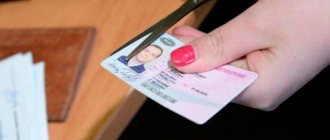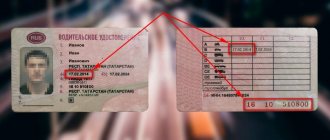How are traffic fines paid?
The traffic police issues a resolution. The driver was speeding and the camera noticed it. It automatically sends a photo of the violation to the traffic police server. The traffic police officer receives the photo from the server and checks it. If there are no errors in the data about the driver and the car, he issues a decision.
The fine appears in the database. Information about the violation remains in the traffic police database and is duplicated in the state information system on state and municipal payments (GIS GMP).
The driver pays. As soon as the driver pays the fine, information about the payment will be sent to the GIS GMP.
The fine has been paid. After this, the debt disappears from the traffic police database - the driver has no debts on fines.
If the payment was made through “Traffic Police Fines”, the payment history is saved
Payment of the fine in installments
According to the Administrative Code, namely Article 32.2, any fine must be paid within 2 months from the date the resolution came into force . The countdown begins 10 days after the driver receives a copy of the resolution by mail. A couple of weeks will pass from the moment the violation is discovered. Therefore, as a result, the driver will have at least 3 months to pay the debt.
The full period of the general payment obligation consists of the following periods:
- Time from the moment a violation is detected and a resolution is issued, if the violation is recorded by a camera.
- 10 days from the date of delivery of the resolution until the document comes into force.
- 2 months to pay the debt - during this time the amount can be paid in installments.
Is it possible to pay the traffic police fine in installments?
Yes, the fine can be paid in installments. In paragraph 6 of the instructions for users of the GIS GMP database it is stated that there can be several payments for one accrual.
This can be done if the payer knows the payment details and is ready to patiently enter them in the bank terminal or in the bank application. You can find out the details in two ways:
- from a paper decree,
- on the State Services website.
Let's look at both options.
A paper order arrived. On the resolution form, after the description of the violation, there are details that can be used to pay the fine.
Using the details in the paper order, you can pay the fine at any bank. Example from 11.mvd.rf
An electronic fine has arrived. In the upper right corner of the State Services website, click on your name and initials and select “Review”.
Find the fine in your service history and click on it. A page with details will open.
Next, click “All details” - a window with details will open.
In case of partial payment, the money does not always reach the recipient. To prove payment, keep payment receipts.
It’s easier to pay the fine through special services - all you need is a car number and a vehicle registration certificate. You can pay in the first 20 days at a discount.
Filling out an application to pay the traffic police fine in installments
Documents for registration
You need:
- resolution;
- income certificate;
- any other documents confirming your difficult financial situation.
Technically, you can do without the last two points, but installments are not given just like that: you need to prove that the plaintiff’s financial situation is really difficult. An income certificate is a very good argument (if income is really low). By the way, clothing also indicates wealth, so dress more casually when you go to court or the traffic police.
The resolution is needed in order to indicate its number in the application. The list of other documents depends on the specific situation: for a single mother with two children - a certificate of alimony, for a person with a serious illness - an extract from a medical record and medical bills. Anything that convinces the official that you have a problem will do.
How to fill out an application correctly
The application is not regulated by law, therefore it is drawn up in free form. At the top right you need to indicate the organization you are applying to and the person who will consider your application. Immediately below the full name of the official is the full name of the petitioner, in the genitive case (from whom? Nikolai Alexandrovich Ivanov). Below is the word “Statement”. Below it is the text of the statement. The text must indicate: the essence of the request, the number of the decision on administrative punishment, documents confirming the difficult financial situation. The document ends with the current date (left) and last name/first name/patronymic/signature (right).
Review period
The review period is up to 30 calendar days. If you apply in person, there is a high chance that your application will be considered on the day of your application. By the way, it’s better not to go to court, but to the head of the traffic police: he will consider the application faster. Please note that failure to pay a fine leads to another fine, and if you write an application, it will be reviewed after the payment deadline and not approved, then you will have problems. Therefore, do not delay in applying.
How to submit applications to pay a fine in installments
The law allows you to ask for installments for three months. Such a request must be sent to the traffic police inspector who issued the resolution.
To write an application. In your application, write the reason why you cannot pay the fine on time. Such a reason could be a difficult financial situation, illness, loss of a job or debt obligations to the bank. Complete the application with documents: a bank statement or a certificate from a medical institution.
Collect documents. You will need:
- copy of the passport,
- copy of the resolution,
- application for installment plan,
- certificates confirming insolvency.
The inspector will review the application within 30 days.
There are exceptions when you cannot ask for an installment plan or deferment:
- speeding fine;
- fine for transporting people or goods on vehicles not registered in the Russian Federation;
- fine for violating the requirements of signs and markings;
- fine for non-payment to the Platon system - for trucks heavier than 12 tons.
How to apply for installment payment
Is it possible to pay off a fine in installments over a period longer than the statutory period of 60 days? Yes, this can be done if the violator cannot pay the fine 2 months after the ruling is issued. For example, the fine can be set in the amount of 30 thousand rubles, according to the Administrative Code, Art. 12.7, or for refusing a medical examination, or for driving while drunk. For many people, paying this amount is only possible in installments. But 60 days may not be enough for this.
Payment by installments is allowed. By law, the head of the traffic police or a judge can grant a longer payment period of up to 3 months, taking into account the difficult financial situation of the offender.
If the judge makes such concessions, the violator can pay the fine in separate installments. The amount and time of payment are set by the driver independently.
What if the case goes to court and the fine is too high?
Alexander Torvard, auto lawyer Almost always a large fine is accompanied by deprivation of rights - and this is always a court case. It is at the trial that you can ask for an installment plan. In this case, of course, attach evidence of insolvency.
The court considers violations when, for example, the driver was drunk or left the scene of an accident. At the court hearing, voice your request and support your words with documents:
- application for installment plan;
- expected payment schedule;
- documents that confirm the impossibility of paying the fine.
If the judge takes into account all the explanations, the payment period will be increased to three months.
Also, the law allows you to ask for a delay of a month.
What if the payment was not completed in full?
If, during the check, the status of the fine remains “Unpaid,” then it still exists in the GIS GMP database.
This can happen for several reasons:
- the bank did not transmit payment information;
- the payer made a mistake with the details;
- failure in GIS GMP.
If the last fine payment did not go through, follow these steps:
- collect all checks and receipts from the bank;
- request information about them from the bank and make sure that the bank transferred the money according to the details;
- send payment documents to the traffic police by registered mail or with a personal visit.
- wait for a response. Duration: 10 days.
How to pay a fine in installments in 2021?
In accordance with Art. 32.2 of the Administrative Code, any administrative fine must be repaid within 60 days from the date of entry into force of the resolution by which it was imposed. The expiration of this 60-day period begins 10 days after the driver receives a copy of the decision by mail. Until this moment, at least another 10-15 days will pass from the moment the violation was recorded. And thus, in total, the driver will have about 3 months to collect and contribute money to the budget.
That is, the total period of obligation to pay in full includes the following periods:
- some time between the date of recording the violation and the issuance of the decision in the case of a fine on camera,
- 10 days from the date of receipt of a copy of the resolution until it enters into force,
- 60 days to pay the fine directly – and during this period it can be paid in installments.
The amount of the fine within the specified 60 days is transferred by the violator or deposited into the cash desk of the bank, which is the paying agent for transferring money to the budget (Part 3 of Article 32.2 of the Administrative Code). However, the legislator does not specify whether this must be done as a one-time payment or whether the fine can be paid in installments. But since partial payment is not expressly prohibited by law, it is logical to assume that the violator can deposit money in several payments - the main thing is that the last tranche is transferred no later than the above 60 days have expired.
For example, a fine of 30,000 can be paid in installments in 3 installments of 10,000, paid every 20 days.
If the driver manages to deposit the money within 20 days from the date the resolution comes into force, he is entitled to a 50% discount - this amount can also be paid in installments.
When paying a fine in several payments, it is important to indicate the details of the same administrative resolution in the purpose of payments. It is equally important to keep all receipts for a specific resolution, since information about payment may not be received by the GIS GMP on time, in which case the fine will be considered overdue.
Remember
- You can pay the fine in part, but to do this you need to know the recipient's details. They can be viewed on a paper decree or on public services.
- Even if you pay the fine in installments, you must do so within 70 days from the date of the decision.
- If the fine is large and there is no money to pay, write an application for installment payment and submit it to the person who is considering the violation case - an inspector or a judge.
- If you paid in installments and the fine has not been paid off in the traffic police database, check that the details are correct. If everything is correct, send checks and receipts to the traffic police by registered mail or with a personal visit.
All articles by the author: Evgeniy Lesnov
What happens if the fine is not paid on time?
If the GIS GMP does not contain information about the driver paying a fine or he himself did not provide copies of receipts to the traffic police, the punishment will be more severe.
- Firstly, a copy of the resolution will be sent to the FSSP unit at the driver’s place of residence for forced collection of a fine (Part 5 of Article 32.2 of the Administrative Code). In this case, the driver will likely have to pay not only a fine, but also an enforcement fee (7% of the fine), as well as the costs of enforcement proceedings. If the money is not deposited, the bailiff will be able to seize it and write it off independently from a bank account, deduct it from wages, or receive it from the offender’s other income, for example, a pension or scholarship. After the decision is received by the FSSP, the driver can also pay in installments, but only if the bailiff does not find a way to collect it at a time faster (for example, from the money in the account or salary).
- Secondly, if the fine is not paid on time, the driver is held accountable under Part 1 of Art. 20.25 Code of Administrative Offenses for evading punishment. The employees who were involved in the violation case draw up a new protocol and issue a new resolution with punishment, in addition to the initial fine. In this case, the driver may be subject to a sanction in the amount of twice the original fine, administrative arrest for 15 days, or up to 50 hours of compulsory labor.










